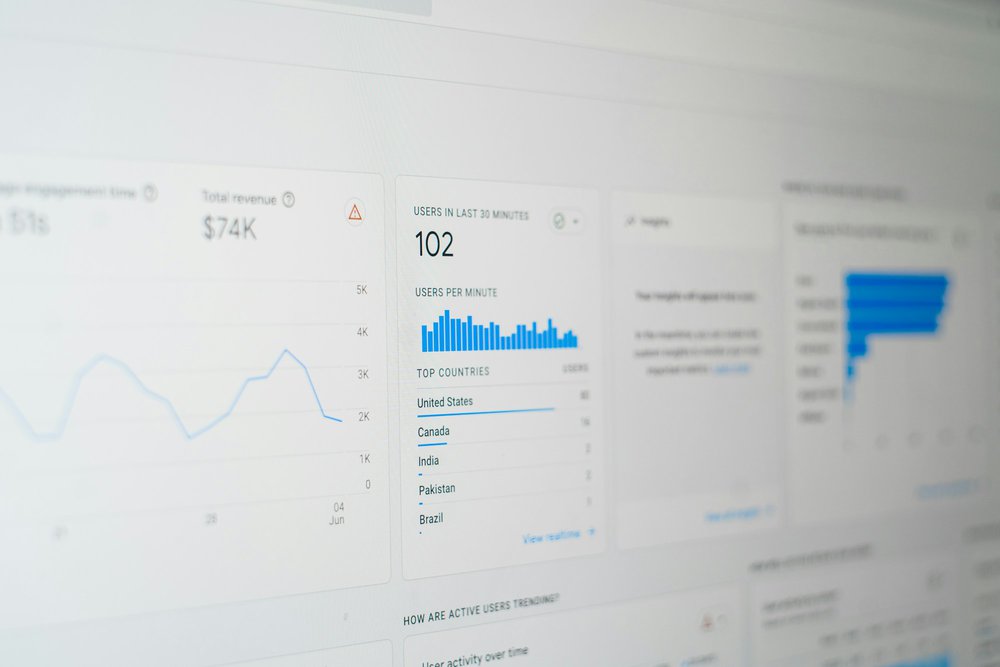Every business is investing in video, but not every business knows if those videos are actually working. Tracking the right video metrics to track is the key to understanding how your entire video strategy performs across channels.
Understanding Key Performance Indicators (KPIs) in video marketing is essential for success. These are the metrics that show how your content performs, how your audience reacts, and how video drives measurable results for your brand.
For B2B and corporate teams, understanding video metrics like engagement rate, watch time, and conversions can turn creative ideas into real business outcomes. When you track the right data, your videos stop being just content; they become one of your most valuable growth tools. The right video ROI insights help you measure your content’s financial effectiveness and compare results between platforms like LinkedIn or YouTube video ads.
What Are Video Metrics?

Video metrics are the numbers that show how your videos perform across platforms. They reveal how people watch, engage, and respond to your content, from the first click to the final frame.
Are viewers watching all the way through or dropping off after a few seconds? Are they sharing your video or scrolling past it? These insights help you understand what captures attention and what needs refining. Different video platforms and social media channels provide their own dashboards, but key video metrics differ only slightly; view count, play rate, and average view duration are universal signs of engagement.
Each particular video you publish creates new data points that tell you how video viewers respond. Compared to text or image posts, videos usually generate higher engagement because they’re dynamic, emotional, and easier to digest. That power also means you need to track performance more closely.
Most video engagement metrics fall into three main categories:
- Quantitative metrics: Measurable numbers such as views, watch time, likes, shares, and comments.
- Qualitative metrics: Contextual insights like audience sentiment in comments, survey feedback, or message responses.
- Conversion-related metrics: Actions tied to outcomes, like click-through rate (CTR), form fills, or demo requests.
Quick Insight: Video metrics show you what’s happening. Video KPIs tell you why it matters. Tracking video analytics consistently helps connect creative work with measurable goals across your video campaigns.
How Video KPIs Drive Business Growth (and Why They Matter)

Marketing videos have become one of the most effective tools for businesses to grow awareness, engage audiences, and drive measurable results.
Video KPIs give you the insight to see which content performs best, how your audience engages, and where your strategy needs to improve. They turn creative work into measurable performance, helping your team make informed decisions instead of guesses.
According to HubSpot’s State of Marketing Report 2024, 91% of marketers say video helps them generate leads, and 88% report a positive return on investment. In that projection, video ads are expected to outperform other formats in engagement.
Let’s take a deeper look..
1. Engagement
Engagement shows how well your video connects with your audience. Video posts now get ~5.60 % average engagement on LinkedIn, up from 4.00 %.
Tracking video engagement metrics like likes, comments, shares, and watch time helps you see what content resonates most. It’s also smart to review view count and video plays, how many people hit play, and how long they stay. These key metrics help define your audience’s behavior. In B2B settings, engagement also reflects credibility, the stronger the engagement, the stronger the trust in your brand.
2. Understanding
Explainer videos, software demos, and training videos are ideal tools here. In fact, 99 % of video marketers say video improves how people understand their product or service. When viewers grasp your message easily, it reduces confusion, builds confidence, and moves them closer to making a decision. Educational videos are a great example for this, they simplify complex ideas while keeping video engagement high.
3. Visibility
Video is also a major SEO driver. Optimized video titles, descriptions, and transcripts improve your visibility across Google and YouTube. More visibility means more eyes on your brand, and more opportunities to capture qualified leads. An optimized video thumbnail and clear titles can increase your play rate and help viewers find your content faster in search results.
4. Website Traffic
Videos keep people on your site longer. When your video shows up in search or social feeds, it becomes a north star for traffic. HubSpot finds that landing pages with video see significantly higher session lengths and engagement than pages without video. More time spent means higher chances to convert visitors into leads.
5. ROI and Strategy
Video continues to deliver strong returns. In 2024, 73 % of marketers said video helped them hit business goals. Also, 93 % of marketers report video gives them a positive ROI, the highest that Wyzowl has seen.
The most effective teams don’t just post videos, they measure performance. Tracking conversions, retention, and lead quality helps you refine future content and prove ROI.
Repurposing one video across multiple platforms multiplies results and extends reach without extra cost.
Key Video Metrics to Track in Your Video Marketing Strategy

Video can make an impact at every stage of the buyer’s journey. From introducing your brand to closing a deal, tracking the right video KPIs helps you measure success and see where your strategy is working.
Most businesses break this journey into three stages: Awareness, Consideration, and Decision. Each one has its own set of video metrics that reveal how your content influences potential buyers.
Awareness Stage KPIs (Impressions, Reach, Brand Awareness)
At the awareness stage, your goal is simple: help people discover who you are and what you offer. Brand videos, company stories, and overview videos introduce your message and make your brand memorable.
1. Impressions
Impressions show how often your video appears across LinkedIn, YouTube, and other platforms. Tracking this through Google Analytics or native video analytics tools helps you spot strong distribution channels early. This metric helps gauge brand visibility and the effectiveness of your distribution strategy. For B2B teams, it also reveals how often your message reaches decision-makers in key networks.
Pro Tip: Track impressions over time. Steady growth means your content is being surfaced more often by the right platforms.
2. Reach
Reach measures the number of unique viewers who saw your video. It helps you understand audience size and quality.
For example, one Levitate client in tech saw a 42% lift in qualified leads after expanding distribution from social media to YouTube and their homepage. Comparing reach across channels helps identify where your highest-value viewers come from.
3. Brand Awareness
Brand awareness measures recognition and recall. In B2B, it comes from consistent, authentic storytelling.
Publishing brand videos, testimonials, and thought-leadership clips helps your audience remember you when it matters most.
Consideration Stage KPIs (Engagement, Video Views, Conversion Rate)

Once your audience knows who you are, the next step is getting them interested enough to take a closer look. At the consideration stage, your video content should educate, engage, and build trust. This is where potential buyers compare options and decide which solution fits their needs best.
1. Engagement
Engagement measures how viewers interact with your videos, things like likes, comments, shares, and other signs that show they’re genuinely interested in what you’re posting. For B2B marketers, it goes beyond reactions; it reflects genuine attention and intent.
Track video engagement metrics like average watch time, view duration, and click-through rate. These reveal how well your content holds attention and how motivated viewers are to take the next step.
Webinars, customer stories, and case study videos perform best at this stage because they show real-world results and make your message more relatable. At this point in the marketing funnel, shorter videos with interactive elements like polls or CTAs keep prospects watching and encourage a desired action.
2. Video Views
Video views track how often your content is watched by both new and returning viewers. Unique views show reach, while repeat views signal stronger intent and interest.
If people rewatch a product demo or testimonial, they’re likely validating your solution before taking action. Tracking these viewing patterns reveals which videos build the most trust.
3. Conversion Rate
Shows how many viewers take action after watching, like booking a demo, visiting a page, or completing a form. It’s one of the clearest signs of how effectively your video moves prospects through the funnel.
Placing testimonial or explainer videos on landing pages and in emails can boost conversions by building trust and answering questions at the right moment.
Decision Stage KPIs (Conversion Rate, Bounce Rate, Repeat Purchase)

At the decision stage, your video content should help potential clients feel confident choosing your brand. This is where case study videos, detailed demos, and testimonial videos shine. These formats give buyers the final proof they need to make a decision.
1. Conversion Rate
This shows how effectively your video turns interest into measurable results. It could be a lead form submission, a booked meeting, or a direct purchase.
According to HubSpot, adding video to a landing page can increase conversions by up to 86%, while a study cited by VBOUT found that video content can improve landing page performance by as much as 80%.
For B2B sales teams, this is especially valuable. Videos used in proposals, email campaigns, or product pages can clarify complex offers and make it easier for stakeholders to say yes.
2. Bounce Rate
Bounce rate tracks how many visitors leave your page without taking any action. A high bounce rate often means the video or landing page doesn’t align with viewer expectations.
Monitoring this metric helps identify where potential customers lose interest. When viewers lose interest, look for drop-off points and test variations of your script or visuals. For instance, if visitors click away early, your video might be too long, unclear, or misplaced within the buyer journey. Testing shorter, more focused clips or adjusting placement can improve retention and keep prospects engaged longer.
3. Repeat Purchase Rate
Repeat purchase rate measures how many existing customers buy from you again. It’s a key indicator of loyalty and long-term value.
Personalized follow-up videos, thank-you messages, and value-driven tutorials all help nurture customer relationships. 93% of marketers say video delivers a positive ROI and helps strengthen customer relationships. When clients feel seen and supported, they’re more likely to stay connected and purchase again.
B2B brands that use ongoing communication, such as quarterly updates or feature highlight videos, often see higher retention and stronger lifetime value.
4 Factors That Impact ROI

No matter what stage of the customer journey you’re looking at, you’ll always want to track your return on investment (ROI). This is the financial return you receive from the marketing video campaign.
1. Type of Video Production
The purpose behind your video drives how ROI is measured. No two videos are created equal; each specific video has a unique goal, message, and target audience. A brand video that builds awareness will deliver different results than a sales demo designed to convert leads.
In 2025, high-performing B2B brands use a mix of formats such as testimonial videos, corporate explainers, and product demos to achieve different business goals. The key is aligning each production with a specific stage of the funnel and tracking its video performance through metrics like engagement rate, lead quality, and conversions.
2. Video Length
Attention spans are short, but the right video length depends on the goal. Short clips often drive awareness and social engagement, while longer videos, like webinars or in-depth demos, work best for audiences who are closer to making a decision.
For B2B marketers, testing is key. Tracking metrics such as average watch time, retention, and drop-off rate helps identify the ideal length for each type of video. AI-driven video analytics tools now make it easier to compare viewer behavior and optimize future content.
Quick Insight: Data shows that 2–3 minute videos perform best for awareness, while longer-form content builds trust in later funnel stages.
3. Video Placement
Where you publish your video is just as important as what’s in it. Placing videos on landing pages, email campaigns, and LinkedIn posts can dramatically affect performance.
Omnichannel distribution is now the standard. Embedding video across your website, social feeds, and paid campaigns ensures your content reaches audiences at multiple touchpoints. For example, videos featured on product pages often lead to higher conversions, while posting snippets on LinkedIn or YouTube boosts engagement and visibility.
4. Call to Action (CTA)
A strong call to action turns attention into measurable results. Whether you’re asking viewers to request a demo, download a guide, or book a consultation, your CTA should be clear, actionable, and relevant to the content they just watched.
For B2B brands, including tailored CTAs throughout your video not just at the end, helps guide prospects through the buying journey. Pairing these with trackable links or QR codes allows teams to directly measure response rates and ROI.
Using Metrics to Guide Decisions Will Lead to Business Growth
When you understand your marketing goals and track the right video KPIs, every creative decision becomes strategic. Data shows you what’s working, what’s not, and where to invest next.
Video metrics help businesses move from guessing to knowing. They turn creative storytelling into a measurable engine for awareness, engagement, and revenue growth.
By consistently tracking and improving video ROI, you’ll see how your new video initiatives perform across different social media platforms.
FAQs
What are the most important video KPIs to track?
The key video KPIs to monitor include engagement rate, watch time, click-through rate, and conversion rate. These metrics show how well your videos capture attention and drive results. Learn more about tracking performance in our Video Analytics Guide.
How do video metrics matter for ROI?
Video metrics reveal which content performs best, so you can focus resources on what works. When you track engagement, retention, and conversions, you can adjust your creative and distribution strategy to increase ROI across campaigns.
How can social media videos support a B2B marketing strategy?
Short-form and social media videos boost visibility, drive engagement, and help brands stay top-of-mind. They’re ideal for awareness and lead generation when paired with consistent posting and strong storytelling. Explore our Social Media Video Services for ideas tailored to your business goals.
What role do CTAs play in video performance?
A clear CTA turns views into measurable results. Whether it’s scheduling a demo, downloading a resource, or contacting sales, CTAs guide your viewer’s next step. For best practices, see our article on The Power of Video CTAs.
Can tracking KPIs help refine future video strategy?
Absolutely. Reviewing your video KPIs after each campaign helps identify patterns in viewer behavior. Many Levitate clients, including SquareTrade, use data from past videos to refine messaging, improve storytelling, and strengthen future production plans.
Great storytelling only works when it’s backed by the right data. Our videos are built to perform, crafted with clear KPIs and successful video marketing strategy from start to finish. Contact Levitate Media to start your next project.









